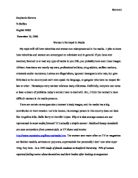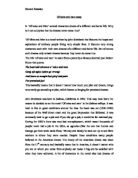The plot of “Angels & Demons” introduces the main character Robert Langdon, Professor of Religious Symbology and art history at Harvard University who was asked to help solve the murder case that happened in the Swiss Center of Science called CERN. One of the top physicists was found dead with his chest branded with the word "Illuminati." After he created the antimatter that was capable of wiping out the whole country it was stolen and he was murdered. The stolen antimatter was going to be used by the Illuminati group in Vatican, in St. Peter's Cathedral the day of the election of the new Pope to wipe out the center of the entire Catholic religion. All of the events in this book take place in Rome. The author pays very close attention to detail of Rome’s architecture. The reader is taken on an excursion of architectural masterpieces of Rome. But, this book doesn’t just give the excellent description of the Vatican, it also creates atmosphere of the fascinating detective story, and its outcome gives the reader a surprising ending.
“The Da Vinci Code” was the continuation of the novel of “Angel and Demons”. The novel is written in a genre of an intellectual detective thriller. “The Da Vinci Code” is a great history lesson about ancient Christianity and matters related to The Holy Grail. This book starts out with the same character Robert Langdon, solving the murder of the professor Jacques Sonera of the Louvre Museum in Paris. The body of Sonera was found in the Louvre bared and located the same as in Leonardo da Vinci's well-known drawing “Vitruvian Man”, with the ciphered inscription on its chest. This inscription on the body specifies that it is necessary to search for a key to secret of murder in Leonardo da Vinci's works. Robert Langdon used the works of Da Vinci as "Mona Lisa" and "The Last Supper” which give him clues to this puzzle. In the novel there are some parallel subject lines in which various characters participate. In the end of the book all subject lines gather and resolved. The ultimate solution is found to be connected with the possible location of the Holy Grail and to a mysterious society called the Priory of Sion.
In both books Robert Langdon is a protagonist that you can't dislike in any way. Langdon understands enough about each mystery to go in search of the missing pieces necessary to solve each puzzle, which leads him to the next one. Both share a hired assassin, a tough and beautiful woman as Langdon's sidekick and mysteries that require extensive knowledge of art history, religious symbology, and secret societies.
Both stories have the same basic plotline. Like “The Da Vinci Code”, “Angels and Demons” packs all of its action into 24 hours. It involves mysteries and religious controversies from hundreds of years ago. In one story there is a grandfather-granddaughter relationship that is crucial and in another case it is father-daughter, but in both cases the parent figure has actually adopted the child. There are four brutal murders at the center of the plot of both books. In both books, a message is written on papyrus-based paper. This is later destroyed when the paper comes into contact with vinegar and water.
“Angels and Demons” has a more suspenseful storyline with the antimatter bomb and the race to prevent the destruction of Vatican City. On the other hand “The Da Vinci Code” was easier to fallow and less farfetched, which is why I think that has made it more popular in the end. “Angels and Demons” does a better job of taking a reader through the mythology (although created mythology) of the Illuminati and the reader "see" it everywhere in the book. The two books differ in setting, threat, and focus. While “The Da Vinci Code” tackles ancient speculations about the Holy Grail, “Angels and Demons” involves more standard thriller fare. For those who love plot-driven novels and for those who love thrillers and mysteries full of strange bits of information that tie everything together, I would advise to read “Angels and Demons”.







